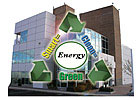
Considering the intersection of buildings energy and environment, the graphic below was used at the recent BACnet International meeting and Building Automation & Sustainability Conference, sponsored by Engineered Systems to illustrate a point. This is a simple message: smart buildings use energy in a clean and efficient way thus becoming green buildings. Clearly, this is not in complete synchronization with the USGB’s LEED® definition of green buildings, but in the larger context of energy and the environment, building intelligence may be more critical than many other factors. Recent data from the DOE indicates that electricity generation is responsible for 39% of greenhouse gas emissions, and the American Institute of Architects credits buildings alone with responsibility for 48% of greenhouse gas emissions.
There is some overlap between these numbers since buildings are large electricity users and the burning of fuel to produce that electricity is what causes greenhouse gas emissions. There has also been solid research done to validate the fact that these emissions increase at times of peak demand. This is because utilities must fire their least-efficient and highest-polluting plants to meet peak demand. This is really just another way to embrace the whole idea of green buildings, but more importantly to emphasize the HVAC, automation, and energy part of that equation. Integrators can’t tell a story about how our work addresses building sites, urban redevelopment, bike racks, or recycled carpet. They can however tell a story about energy and demand response, plus they may be able to help pay for their services with dollars from the utility.
The GridWise Architecture Council (www.gridwiseac.org) recently sponsored an event focusing on the idea of interoperability between the grid and consumers. This gathering was part conference, but more importantly, it was an outreach effort on behalf of GridWise to seek input and develop collaboration between a diverse group of industry participants. These participants including building industry thought leaders like Jim Lee of Cimetrics and Toby Considine of the University of North Carolina and Chair of the oBix committee. A number of industry experts in the area of demand response (DR) also participated, includedMary Ann Piete of the Demand Response Research Center and Tim Daniels of Constellation NewEnergy, plus a number of participants in the NewEnergy Alliance. This alliance is made up of manufacturers and integrators in the buildings space who see DR as a major near-term opportunity for building systems and are joining together to educate the automation industry about the potential. One of the goals for this event was to forward a framework for understanding what is necessary to integrate buildings and the electric grid.
The council is trying to act as a catalyst for technology that will reduce the distance to integrate building and electric systems in a way that brings value to both. With a forecasted 40% increase in electric demand and an expected need for $900 billion in electric infrastructure investment to keep pace with that demand, smart buildings can play a huge role in relieving pressure.
That means that the building can be viewed as a source of power and that automation systems can execute new strategies to shift load and take pressure off of peak demand time. Through DR, the customer gets paid for doing this, which generates cash to buy or expand and upgrade automation and energy management technology. This is a real opportunity to leverage programs from independent system operators (electricity wholesalers) and the utilities (electricity retailers) who are willing to pay owners cash to help them shift load from critical peak periods.
The translation is that customers may be able to pay for controls upgrades with the utilities money. This is a billion dollar market, and to really be successful, it will have to leverage the control capability of automation systems. It is particularly about using interoperability to enable new business models that allow for the transaction associated with buying and selling electricity to be opened up. Think of our early experiences with the Internet to just surf or send an e-mail, and consider now how companies like eBay, Amazon, and Google have built business models that are highly profitable. In just the same way, DR is a great example of how automation technology is being used to help utilities control and shift the demand for power at critical times, and in return resulting in a very real business proposition that will bring value to the electric system and revenue to building owners and control companies.
A great opportunity for the buildings and systems industry to learn more about this opportunity will be at the AHR Expo in New York this January 2008. The GridWise Architecture Council is an endorsing organization of this show and will be offering two free education sessions, to learn more about GridWise and how it will affect buildings (www.ahrexpo.com/education/freesessions.php). One session at AHR will be on global warming and GridWise and the second is titled, “The New Building Automation: Energy Demand Response.” GIB
